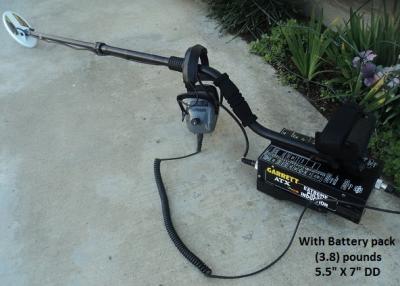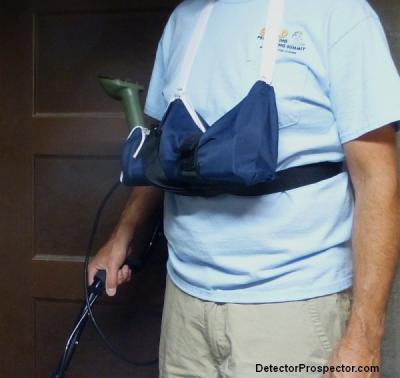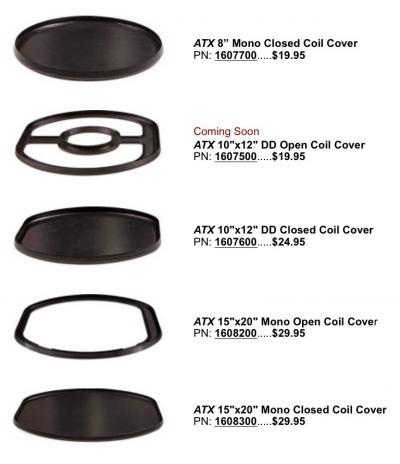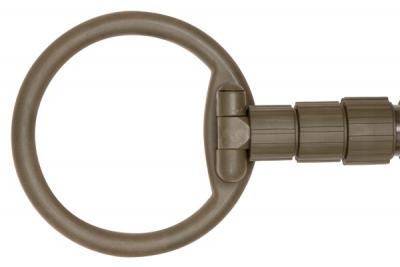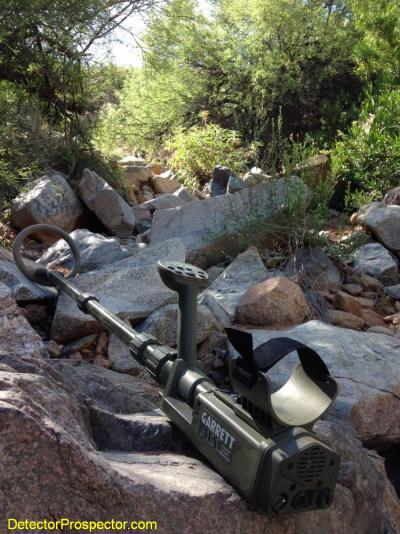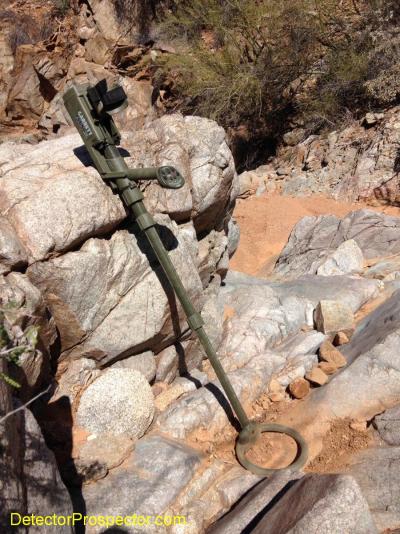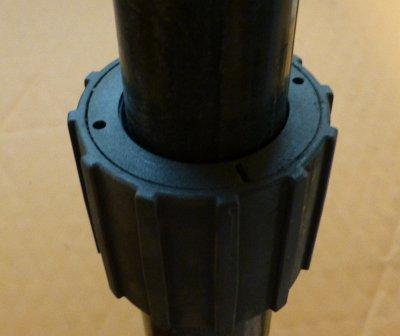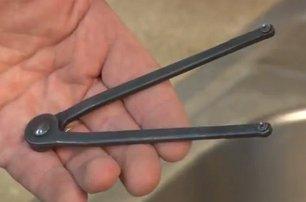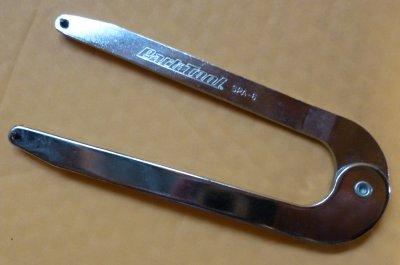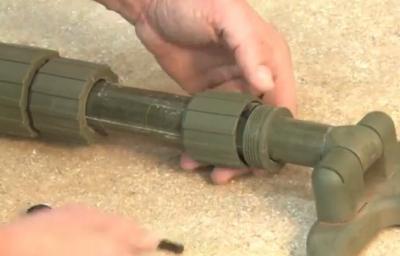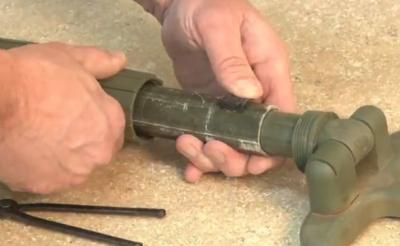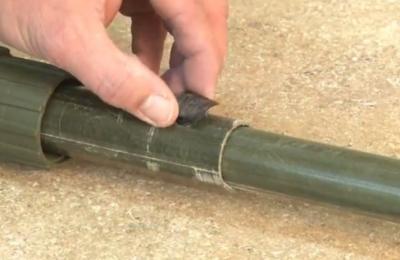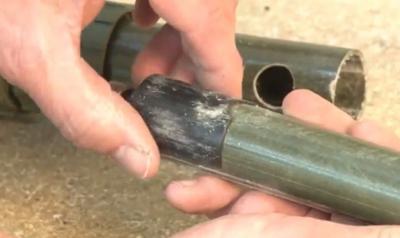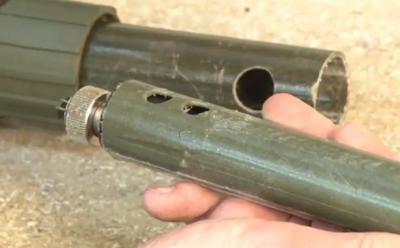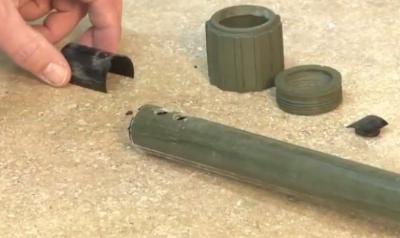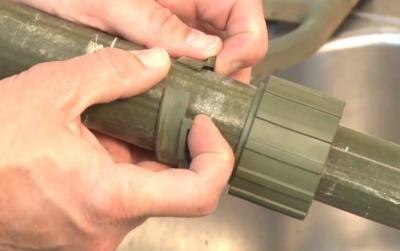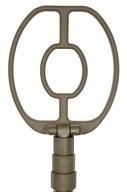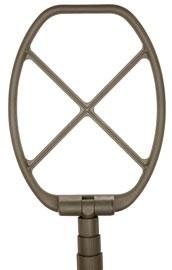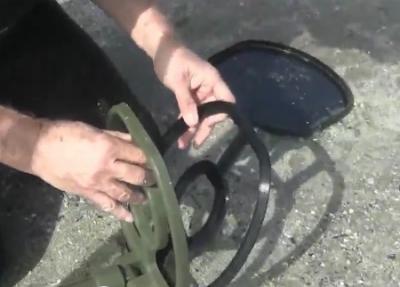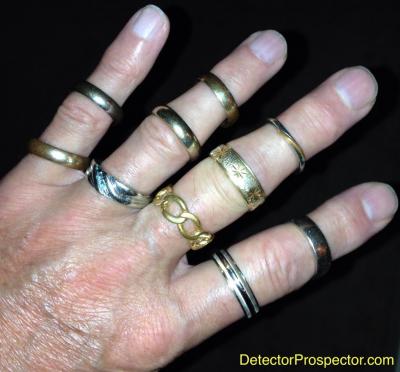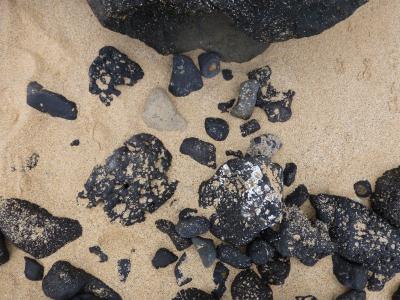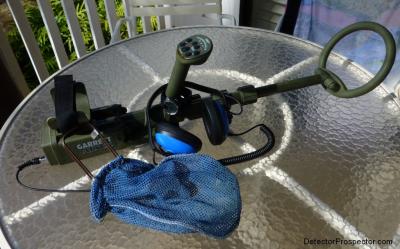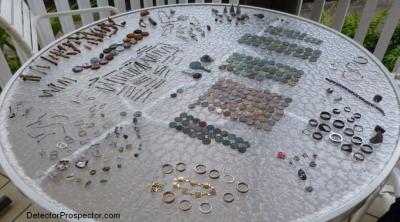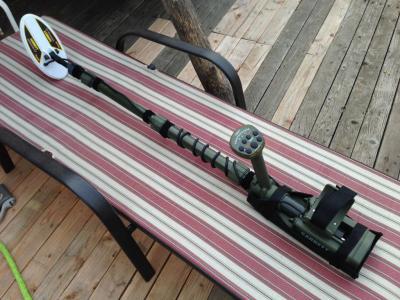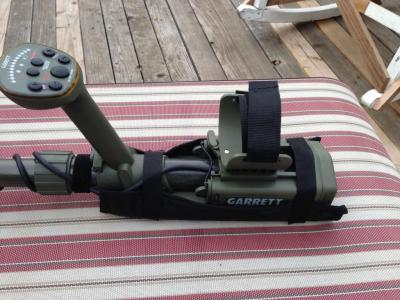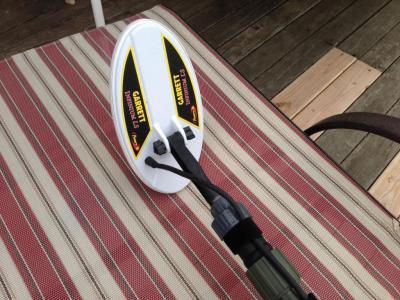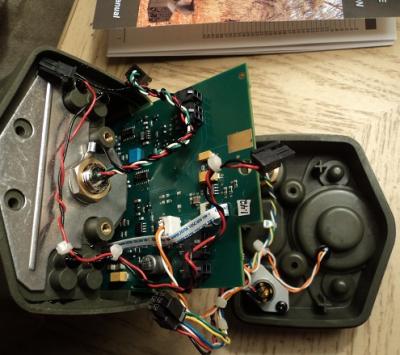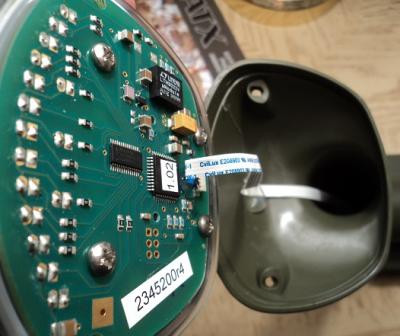Search the Community
Showing results for tags 'garrett atx'.
-
Anyone have values of each coil weights and shaft weights - carbon and OEM?
-
8 inch coil hasn't any serial number... so I think this is the same coil from Recon... how to check it?
-
Hi, I have a Garrett ATX and have done some nugget detecting with it. See Gold Nugget Detecting with the Garrett ATX. However, the weight and the stock coil had me wishing for options. I wanted a smaller coil with no openings to hang up that could get into tighter locations. As a past Infinium owner the 10" x 5" DD coil immediately came to mind. See Detecting with the Garrett Infinium in Hawaii and the first picture will tell you what was going through my mind as I hunted gold nuggets. So I have some Garrett Infinium coils I am trying on the ATX. The full story and photos are at my new Garrett ATX Accessory page. I will be updating it as I experiment more with the concept. An obvious alternative would be to make an adapter to mate a standard lower rod assembly to the ATX (it has already been done for the Recon) but I wanted to go hip mount for the least weight on my arm possible. I want to note here I am advocating nothing and recommending nothing. This is just something I am doing that may answer some questions for some people. If nothing else it will save somebody else making a duplicate effort or wasting the time and money on something that may or may not work out. Bottom line is I just have to know for myself so I will find out and report back as I go along. This thread will be the official question and answer thread for the experiment.
-
Not as pretty as I'd like but it's a start, This housing is big enough to hold the current ATX or Recon circuit board after cutting off the excess board. Will use a Tee handle not the S-handle as shown in the pic, Tossed that in there for a quick photo shot. Going to park this housing, Maybe after the ATX warranty expires will break one down and go with this land version. Still need to construct the push pad controls to fit above the tee-handle, Minor mod and no hurry since this will be parked for a while unless I go forward with fitting the Recon on this land setup? Tossed this out there to give you an idea of what the housing will look like, Looks ok and will look even better when its completed. Paul (Ca) Update, The S-handle works better than expected, Feels balanced and after more thought may stay with the S-handle. Total weight with an 8-cell battery pack, 5.5"X7" DD and dummy circuit board is 3.8 pounds.
-
I did a post a while back about putting the Garrett ATX control box in a backpack for use with an Infinium DD coil on a rod assembly. The post and photos are at http://www.detectorprospector.com/forum/topic/58-garrett-atx-backpack-modification/ Works well but obviously making adjustments to the detector is a pain if need be. So I whipped up this simple chest mount configuration using a broken arm sling I got at Walmart for $10 plus an adjustable strap I had sitting around. Easy, effective, and allows easy access to the ATX control panel. There are all sorts of variations a person could come up with.
-
Hello all, Just a question to those who have the ATX. Anybody take one along with them to the rivers? How did it do? Which coil? I know it still may be a little cold in the rivers, but i figured someone is crazy enough to jump in the snowmelt. Thanks
-
All the nugget hunting I have done with the Garrett ATX so far was done with the standard 10" x 12" DD coil that comes with the unit. That coil is a very good coil but as my story at http://www.detectorprospector.com/steves-mining-journal/gold-nugget-detecting-with-garrett-atx.htm illustrates it has a couple quirks. The best sensitivity to small gold is in the inner coil area so it is hard to get the hottest portion of the coil close to objects like rocks or stumps. But the main problem is the DD coil is prone to false signals when knocked, making it tiresome to manipulate in rough ground. I hoped the 8" mono might help with these issues. ATX™ 8 inch Mono Searchcoil PN: 2234000 So I put in quite a few hours with the 8" mono in some rough terrain. I was not so lucky as to find any gold but recovered a handful of small ferrous targets, mostly short bits of wire and portions of nails. All pretty small stuff wedged in crevices in the bedrock wash locations I hunted. I also recovered quite a few non-ferrous targets, mostly bullets and some brass rivets. Some of the lead bits were quite small and overall I was very happy with the depth and sensitivity I was seeing. The locations I hunted were not prime gold areas but gold is present and the number of non-ferrous targets recovered proved the places were not completely hunted out yet. The 8" mono proved just as prone to false signals when knocked as the stock DD coil. The good news is it is lighter and the machine balances better with it on so it is less strain on the arm working the coil effectively for long hours. I do not want to overstate this issue with the coil falsing when knocked because I can hunt effectively with an ATX. But it is an issue that needs to be noted. Well designed detector and coil combinations do not suffer from this flaw and it adds extra effort to the hunt being sure to manipulate the coil in a fashion that does not lead to constant false signals. I much prefer coils I can put anywhere I please in any way I please without a false signal being generated. I cannot imagine how the epoxy filled coils can be the source of the issue so I presume it is the cable that generates the signals when moved in the course of a coil impact. Since the coil cable is inside the rod assembly there is not much I can do to experiment with that theory. If the cable was external to the rod perhaps strapping it more firmly in place would help. The 8" mono does have good external edge sensitivity to small items and the coil does work better in rough terrain. You can get the sweet spot closer to obstructions and the edge of the coil can be worked down into crevices. Quite a few of the targets I recovered were in bedrock crevices and sounded directly on the edge of the coil. One big factor with the 8" mono is that the ATX iron discrimination check will not work with it. If you push the button to engage the check you get a repeating tone that tells you the feature is not in effect. The iron check is a nice feature and this alone may deter someone from wanting to use the mono coil. However, I tend towards digging all targets myself so this did not bother me and in fact I am ok with the temptation being removed entirely. Personally I just do not trust discrimination systems much. Overall I prefer the 8" mono operating characteristics and for uneven, rough terrain it is my preferred coil. I also much preferred it for in water use as outlined at http://www.detectorprospector.com/forum/topic/102-garrett-atx-review-beach-detecting-in-hawaii/ For flatter open terrain I would stick with the stock coil. The main problem however is that it is very hard to justify the 8" mono to most people given the fact that when you buy it you are forced to buy an entire telescoping rod assembly also. This drives the price of a decent coil option up to the point where it is a significant fraction of the original purchase price of an ATX. With a manufacturer suggested list price of $529.95 discounted to $450 this coil unfortunately will probably go underutilized by ATX owners.
-
Steve and forum members, The ATX has 4 ground tracking settings, off, slow, medium, fast. The manual describes this as a continuous slow tracking of ground mineralization. It explains how to change settings, but really doesn't explain what it is doing and how to decide what setting to use and when to use. Is this auto ground balance, or something different? What is the significance of the slow, med, fast settings? Thanks for any info you can provide.
-
Well, Garrett put out a video so the cat is out of the bag about the ATX. It is possible to disassemble and clean the coil lower rod and locking cam assembly. There was some debate about this because if you do it you could make things worse. Also, spare parts are not available at this time so if you lose or break something you are up the creek without the proverbial paddle. Be sure you watch the video carefully and never, ever force anything. Please note that all of this applies to water hunters. I can't imagine this being needed in normal above water use. There are instructions starting at 21:30 (near the end) in the new video below: Here are outtakes and basic instructions. First, if you look at the three cam locks closely you will see small indentations on each ring: Each set of indentations is set at a different distance apart so you need an adjustable pin spanner. Garrett is selling one for $35.95: I did not know about Garrett spanner at the time so I went to the REI bike parts area and purchased a Park Tool SPA-6 spanner for $17.95. The pins on it are about 2.2mm and are quite snug in the indents so the holes appear to be about 2.2mm. Also, the clearance is very close between the pins and shaft so I had to grind a bit off each inside edge of the tool to get the pins into the holes. The Garrett will no doubt work perfectly but this one is half the price and you may be able to get it locally. http://www.parktool.com/product/adjustable-spanner-spa-6 Insert the tool into the holes in the ring and apply pressure carefully. If you can't get it apart easily I do not know what to tell you but do not break it! If you mess things up it will probably not be warranty. Pull the cam halves apart and there will be a black tab underneath set in a hole in the shaft: With the tab removed you can now pull the rod assembly apart. Under where the tab was on the inner rod surface there will be a black plastic tensioning shim/plate set into two holes in the shaft. OK, you have taken it apart and have all the parts in front of you: Wash everything carefully with water. I had one cam that would not free up no matter what I did and disassembly revealed sand that I could not get out no matter what without disassembly. I used a tooth brush and got rid of every bit of grit. It appears to me excessive working of the mechanism while full of sand causes more wear than taking it apart and cleaning, but disassembly has its own risks. Basically, I would only do this is normal washing does not do the trick. Again, you are on your own if you break or lose something. Now, reassemble in reverse order. DO NOT use any lubricants or grease that will just attract and hold more sand in the future. The uppermost cam has a ring that must be loosened and moved up the shaft to give the cam enough room to come apart. Pull it carefully apart but do not go so far as to break it. Pry apart until it comes out of retaining holes and slide up the shaft. My advice to Garrett was to make this public but there were serious concerns about people doing more damage than good. The lack of spare parts at this time is especially disconcerting but hopefully will be addressed because these parts are going to wear and going to need replacement. Again, please note that all of this applies to water hunters. Other users need not be concerned. Anyway, I did it myself after I got back from Hawaii. Two cams on my 8" mono rod flushed out just fine but the uppermost one just refused to get fully clean. I blasted it with a Water Pik, I tapped on it while dry, but some grit stayed inside and kept it from moving freely. It still worked, but I could tell it was not right. Disassembly and cleaning did the trick and I am sure it will for others with similar issues. But be careful!!
-
From page 27 of the Garrett ATX Owners Manual: "Coil covers: Use a coil cover to protect the coil from abrasion and damage and prevent false responses that may occur when the coil abruptly impacts a rigid object such as a large rock, etc." I agree, especially when coils have an MSRP over $500, that you want to protect them. Nugget detecting in particular subjects coils to a lot of abrasion and hard knocks. Standard Garrett ATX Searchcoil 10" x 12" (25 x 31cm) DD Coil Part Number 2234600.....$529.95 Optional Garrett ATX Searchcoil 8" (20cm) Mono Coil Part Number 2234000.....$529.95 Excellent depth on small targets. Enhanced maneuverability in heavy scrub and tight areas. Optional Garrett ATX Searchcoil Deepseeker® 15" x 20" (38 x 50cm) Mono Coil Part Number 2234100.....$599.95 Use for locating larger and more deeply buried objects. Includes surface debris elimination. Garrett has been playing catch up, as even existing coils like the round 8" mono do not have a scuff cover available yet. Still, Garrett is on it, and at least two coils are now being made for the stock DD coil, a closed and an open scuff cover. Here is a picture of them but I have not been able to find part numbers yet. Hopefully Ken or one of the other dealers can chime in with part numbers and pricing. Scuff covers for Garrett ATX 10" x 12" DD Coil For those of you without a scuff cover do not be overly concerned. I have been using my ATX full bore without scuff covers and the end result is that the bottoms of the coils are scuffed and lightly abraded. My 8" mono in particular got a hard go of it in Hawaii. The epoxy bottom is tough and it will take a lot of use to have an appreciable effect so I would not worry too much about it from a service aspect. The main concern is when you go to sell the detector, a scuff cover means the coils look closer to new than well used. They are a good investment for that reason alone in maintaining the resale value of the detector.
-
Well, back home safe and sound after a couple weeks in Hawaii with my wife. We visited the island of Kauai for the umpteenth time. We like the laid back vibe, made even more so by being familiar with everything. We do what we both like - she relaxes in the sun and I go metal detecting. And lots of walks and dinners together. I am glad I waited to post this as I have calmed down some now. A post a week ago would have been a bit much and made the Garrett ATX sound like God's gift to metal detecting. Now I can be more even handed about it. I will do up much more of a story for Steve's Mining Journal soon. This is just a post about how the Garrett ATX did for me in Hawaii. The back story is told at Steve's Mining Journal about prior trips made to the same location over the years. Hawaii has always been a pet project of mine as it is the most difficult environment I have even encountered for a metal detector. There is of course the salt water. There is also literally military grade electromagnetic interference (EMI) from military installations plus missile and satellite tracking stations. Finally, there is a mix of non-magnetic coral sands and volcanic basalt derived sands and cobbles. If you stick to the tan to nearly white sands you can get decent performance from many detectors. But when the basalt gets involved is where things get fun. Most prospectors are familiar with basalt rocks and the challenge they present in gold prospecting. Well, just take the same hot rocks and douse them in really salty water and heavy duty EMI and you have Hawaii. Multi frequency VLF detectors like the Fisher CZ or Minelab Excalibur do ok in in the stuff but lack any real punch. They do best in the whiter sands, but the basalt sands and cobbles really leave them feeling gutless. I went to PI detectors early on, and overall probably had my best results with the various White's Surf PI models. Again, however, they worked best in homogenous materials. Places where the white sands and basalt cobbles mixed gave the Surf PI fits as it hit on the basalt cobbles. In darker sand beaches it was near impossible to keep the machine steady over the bottom in the surf, leading to lots of false signaling. I tried several Garrett Infinium detectors in Hawaii and got tantalizingly close to the detector I wanted. The Infinium as a ground balancing PI could tune out the black sands and hot rocks and eliminate many of the false signals. But it introduced just as many if not more by an inability to play well with salt water and EMI. The interference in particular made the Infinium almost unusable at times. I really wanted a stable Infinium, and confirmed this idea by using the White's TDI in Hawaii. It seemed to solve the issues I was having with the Infinium and so I waited for White's to make a waterproof TDI. And waited. And waited. I waited so long that Garrett had time to take what they learned from the Infinium and another model, the Recon, and build a next generation PI, the Garrett ATX. I was cautiously hopeful that all the noise I had made over the years had been heard, but frankly, I was not getting my hopes up too much. On top of that, the good old days are gone. I used to spend a couple weeks in Hawaii years ago and never see anyone with a detector. This trip I saw people every day! Ok, often the same guy but also more different people detecting than probably all my previous trips combined. The competition has gotten fierce by comparison to the old days. And yet I just had my most successful trip to Hawaii ever. I recovered over a couple dozen rings with the ATX and half of those were gold or platinum. Some silver rings, a nice 14K bracelet, and a pile of coins and there inevitable PI junk. You will have to wait for the full story for details and more photos but here is a teaser of many of the good finds taken a few days before I wrapped up. Eight Gold and Two Platinum Rings Found by Steve Herschbach with Garrett ATX in Hawaii (Click on photo for larger version) You can probably see why a post earlier might have been a bit overly excited! This despite bad weather early on and all the extra detecting competition. The Garrett ATX is the best PI detector I have ever used for difficult water hunting. Hands down, no comparison. I have to qualify that by saying that what makes it shine is the severity of the conditions. A person buying it and using it on clean white sands in Florida would probably have a less enthusiastic reaction. There is a lot of confusion regarding ground balancing PI (GBPI) detectors like the Garrett Infinium or White's TDI. They do not air test well against good VLF detectors and indeed do not really perform all that well against them in mild ground. People never really understand what detectors like these are all about until they get into difficult ground. The kind of ground where the best VLF detectors lose half their depth, the GBPI detector just keeps plugging along, and all the sudden now have a big depth advantage. Not because they go so deep to start with, just that VLF detector fare so poorly in really bad ground. GBPI detectors only really shine in the worst conditions. Let that sink in because it is very important. Anyone reading this should not get the idea these detectors are the be all or end all for all circumstances. But when the going gets tough, when other detectors fall on their face, a GBPI detector like the Garrett ATX can be the answer. Tuning a detector like the Garrett ATX can really bother some people. There is this resistance to doing anything that reduces the theoretical max depth of the detector. As soon as you start getting into reducing settings the feeling is that "well, yeah, but now it does not go as deep". The reality is that any machine that can be run maxed out in bad conditions has left some performance on the table. You may be able to max settings in benign ground, but you should have to back off of max settings in really bad conditions. That is why the controls exist - to compensate for bad conditions. The goal is to be set as high as possible while getting stable performance. The ATX is a powerful detector, and so it should be expected the machine has to be dialed back in severe conditions. The ATX has three adjustments that affect the depth. The Gain control is the simplest. You decrease the sensitivity of the detector to help compensate for conditions that are introducing too much noise. Just like the Gain or Sensitivity control on a VLF detector. This control was lacking on the Infinium and is a major reason why the ATX is superior. There is the pulse delay, which Garrett labels as a discrimination control. It is, sort of. Without getting all technical on you it is also a sort of sensitivity control, in that increasing the delay or discrimination also eliminates signals from weak conductor targets like foil, hot rocks, or salt water. This is really the only control you have on the Infinium to deal with false signals and it serves a similar function on the ATX. Finally, you have the ground balance. The ground balance is basically another type of discrimination circuit or filter. The signal produced by the ground is determined and then eliminated. However, this comes at a cost. Items that read the same as the ground signal are also eliminated, and items near to the ground signal will exhibit reduced signals. The White's TDI makes it easy to demonstrate this. You can turn the ground balance completely off, and when you do so the machine air tests far better than it does when you turn the ground balance on. This is because of the subtractive nature of the ground balance circuit on the TDI. Also, because it has a manual ground balance, you can see the effect of tuning the ground balance control closer to and farther from a particular target response. Instead of tuning out the ground the control can be manipulated to tune out other items instead. It is just a basic discrimination circuit. Different ground balance methods can affect items to greater and lesser degrees so the example shown by the TDI should not be taken as being the same with all detectors. But the effect is real and does exist to some degree on all ground balancing detectors, both VLF and PI. So why use ground balance? That should be obvious - to tune out ground responses. If there is no detectable component in the ground you would be better off without the ground balance circuit. Such conditions rarely exist, but they do exist. Absolute pure white coral based sands are one of them. The ATX at its hottest will detect salt water however, and new to the ATX is the ability to ground balance out the salt signal instead of the ground signal, but you are trading some sensitivity for stability doing it. Long round about way to explain that when the Garrett ATX is turned on with factory default settings the ground balance setting is at a minimum. The ATX should be tried first with the factory default setting and on many beaches you will not want to ground balance it. Just leave the discrimination (pulse delay) at zero, set the gain as high as possible while still allowing the machine to be stable, do a frequency scan, and go. In Hawaii at my location however I could not do this. I could on clean sand but not in the cobbles I wanted to hunt. But first, a total surprise. My ATX was almost totally immune to the EMI that I had previously experienced on Kauai without even doing a frequency scan. The frequency scan was basically redundant. That one thing made the ATX a huge advantage for me before I did anything else. I would not have believed it had I not had a White's Surf PI along for backup and sure enough, when I fired it up, the EMI was there. It was discernible in the ATX non-motion mode but even then nothing to worry about. I. Do not know what Garrett did or if I have a magic ATX but this one thing alone really floored me. It absolutely eliminated my number one problem with the Infinium. Basalt cobbles in sand on Kauai A detector with all controls set to max is in theory getting the best depth. But if it is not stable you cannot work with it, so you have to adjust back to find the best balance. The ATX is a very powerful detector and so I found a combination of settings that worked for me to get quiet, stable performance. This is in no way being advertised as a setting to for you to use! It is what I did for this location and other locations will take different settings. In general, the more powerful all your settings can be the better while still being able to have a stable running detector. So the ATX with factory default (minimum) ground balance, zero discrimination (pulse delay), and max gain would be at its most powerful. The worse the conditions, the more you may need to dial the settings back. The problem is with all the settings maxed out the ATX is very sensitive to small gold, but that also means it picks up salt water and hot rocks. I played with the gain control and the pulse delay (disc) control looking for a balance that left the detector running quiet. A discrimination setting of three and a gain of seven made the ATX submerged in salt water run like a VLF. I periodically reduced the disc setting or bumped the gain higher and noise was introduced, so settled on the 3 and 7 setting for my Kauai beach. Then I found a fat basalt rock buried in the sandy bottom and ground balanced over it, eliminating the signal. I would be the first to admit these settings were probably aggressive and of course costing me some depth in theory, but I got what I have always wanted in Hawaii. A PI detector running quiet as a VLF and by that I mean just purring along with a threshold sound, and when it made a noise, it was because I had a target under the coil. Here is another way to look at it. A very hot detector will detect salt water. It will detect hot rocks. And it will detect things you want. EMI can also be an issue. The trick is to reduce the signals from the things you do not want to hear as much as possible while enhancing the good signals as much as possible. It may be letting unwanted signals through will also increase depth on desired targets a bit. It may also be true that too many signals from undesired targets will inhibit success. You have to decide for yourself where the balance lies. If maximum depth is the goal then digging more undesired targets may indeed pay off. In my case I had plenty of targets, so the goal was quiet, efficient operation. I would not hunt clean white sand set like this. I would have the settings maxed out. I had a strategy in mind here, and my goal was to detect in the basalt cobbles. I was not tuning the machine for maximum performance in the easy stuff, but for maximum performance in the worst stuff. I wanted to detect the places where targets were more likely to have been missed by other detectors. Finally, after one go with the stock coil, I switched to the 8" mono coil. A few reasons. First, it is easier to handle underwater and fits in depressions better. It can be pushed through sand ridges and is less likely to move on the shaft. And I could find items edge on with it easier than with the stock coil. By that I mean turn the coil on edge and drag it in the sand and it acts like a pinpointer on small surface targets. The edge of a mono coil is very sensitive. A smaller coil is easier to pinpoint with to start with anyway. And honestly, I used the 8" mono because I was worried about sand getting in the twist locks and giving me problems, possibly even seizing up the rod assembly. The 8" mono and shaft assembly was my sacrificial lamb. If it got totally screwed up my stock coil would still be fine. Garrett ATX with 8" mono coil (goodie bag attached to arm strap, waterproof watch on handle) I may as well relate now that I did have issues with sand in the twist locks but not as bad as anticipated. The lower two twist locks seemed just loose enough that at the end of every outing I just worked them back and forth and the rod in and out and they cleared. But the upper one gave me problems. It got sand inside that refused to come out, even after taking it off and working on it under running water for a half hour. For some reason that upper most twist lock was just a bit tighter to start with and the sand would not clear out. Yet it never quit 100%. I lost most of the ability to twist the lock but it still twisted just enough to hold the rod in place. I am asking Garrett for advice on where to drill a couple holes or maybe slots to see if we can get these things clearing sand a bit better. Overall I actually am ok with them but they need improvement. In other types of sand it could be a big problem. I am going to see if I can get my upper lock to loosen up similar to the lower two and will report back later. The rod assembly got scored up quite a bit from being extended and collapsed with sand in the assembly. I will post photos later. Nothing that bothered me but some might hate seeing their expensive detector getting ground up like this. I have to say at the end of the day the physical design and the rod assembly in the water were nothing short of brilliant. I have given the ATX low marks for prospecting as being a duck out of water. The waterproof design adds weight, complexity, and expense not required for most dry land prospectors. But in the water the ATX felt really, really good on my arm. It is slightly negative so will settle on bottom if released. But not much; it is essentially weightless on your arm underwater. The rod assembly was a dream. I was working in heavy surf with 40 lbs of lead weight on. I steadied myself many times by leaning on the ATX with absolutely no fear it would break, and the rod never slipped. I could get in the shallows on my knees and shorten the rod down as short as I liked. And just right, no fumbling for the right holes, just loosen a twist lock or two and put it right how I wanted it. Better yet, due to the three piece design, I could also extend the ATX to be longer than any detector I have used underwater. I was in 6 foot of water with just my snorkel in the air, and easily detecting around me. I do a lot of breath hold recovery in deeper water and the ATX was just so easy to adjust for whatever depth I was working at. So easy and so solid and tough that I 100% forgive any little work needed to sort out the twist lock situation. This is one really great handling detector underwater in rough surf conditions that would leave other detectors in serious danger of breaking. The 8" mono was perfect for me. It stayed where I put it and I pushed it around a lot. I learned quickly if I wanted to adjust the coil position to be flatter all I had to do is turn the detector over and push down on the nose of the coil. Maybe not as easy as pushing down on the heel of a coil with a rod mounted in the center instead of the rear but no big deal, mainly because the coil stayed put. After two weeks of heavy use I never had to adjust the coil tension and it showed no signs of having any issue with all the sand it ran through. I had no scuff cover, and the coil shows no sign of cracking, just your normal scuffing from use. The epoxy appears much improved from the old Infinium days. A weak point - that tiny spring loaded rod lock, the one you flip to disengage the rod and coil assembly. The tiny spring popped out on me once. I took it apart, made the spring end ninety degrees again, and it worked for most of trip, but slipped out again last day. Not a big deal but needs beefing up. Be sure when twisting the rod and cams while cleaning to not hold the detector body. You will be twisting against that little lever. Hold onto the rods themselves and twist the cams. We need to find out what the part number is for the coil and headphones connector covers. Everyone should have a couple extra. Better yet, a couple spare caps like are fixed to the back of the ATX to cover the male headphone connection when not in use. One of these to put over the male coil attachment point inside the housing would be very helpful when rinsing and cleaning the ATX. Take the coil off, put the cap on, and now no worries while cleaning. I will find out the part numbers and pricing for those and get some and suggest ATX owners do also. OK Steve, quit delaying! What about the rings? I saw no point on beach hunting with all the competition. One guy in particular walked the beach a couple times every day with a Surf PI. I saw a couple Surf PI detectors at work, a Minelab Excalibur, and a Tesoro Sand Shark or Piranha. They all walked the beach and only the Excalibur guy ventured into the trough when it was calmer once. I spent all my time in the surf or deeper water with a weight belt and mask and snorkel. I recover targets by fanning or digging. And I went looking for mixed coral/basalt harder bottoms instead of deep sand. I played on the beach a bit and hit deeper sand underwater but basically all my finds came off of more solid bases. I am not going to say the ATX was some kind of super depth monster. That would be misleading and really missing the entire point. I have no doubt it was getting as good as depth as could be wrung out of the conditions. I was easily getting nickels down to ten inches in the basalt, maybe a tad deeper but honestly it is hard to tell recovering targets underwater while holding my breath in the surf. The real thing I am trying to relay here is the ATX was rock solid, just like using a good VLF above water, but in the worst detecting conditions I have ever encountered. It allowed me to just get on with the business of detecting targets and recovering them. If I was lacking for targets maybe fighting for another inch would be the name of the game but I never ran out of targets. The rings just banged! Nickels hit hard. By virtue of the ground balance system large junk goes low tone and I ignored many low tone targets. That cost me some dimes, copper pennies, and quarters but that is ok. Nickels, zinc pennies, and rings go high tone. As do sinkers, bottle caps, hair pins, and aluminum. Still, being able to ignore low tone targets upped my odds some. Though I dug a lot of low tones also just to learn more and frankly, because I have a hard time passing targets. You just never know for sure until you dig them and I was there to dig targets. Still, this photo shows my target mix skewed to high tone targets. With the exception of a few large items discarded at the trash can this is every item I dug over the two week period and about 50 hours of detecting time in the water. Steve's Finds in Hawaii with Garrett ATX (Click on photo for larger version) Another benefit with the ATX is the adjustable target volume and threshold, a real boon in an underwater detector. I had brought Gray Ghost Amphibian phones with me that started out loud enough but then got too quiet to hear, so I had to FedEx a set of Garrett phones in quick. I like the sound of the Ghosts better but not if I can't hear them. I surmise the sound chamber was filling with water and so will return them to get checked out. First time DetectorPro phones ever let me down. The Garrett phones have a lower tone but worked just fine. The volume and threshold control on the ATX makes them much nicer to use since they can be set comfortably for both above and below water use even though they have no volume control themselves. You can even set the volume on the fly easily while underwater. This is a very nice thing that most underwater detectors lack. I have read a few posts by people very concerned about the placement of the headphone connector. Total non-issue for me. It is under my right elbow and was never a concern at any time. Icing on the cake? The ATX retains all settings when turned off. Once I found my magic settings I was so happy with how the ATX was running I was afraid to change anything and did not have to. Just turn it off, turn it on, and ready to go. Everything is just the way you left it. This is very important with the ground balance setting. It is the one setting you have no idea where it is set. I wish and am suggesting that when the detector is manually ground balanced the LED indications reflect the entire range and show you where you end up at for future reference. Right now the LEDs simply follow to audio and reduce to nothing when the unit is ground balanced. But where am I and can I get back there? You have no idea and neither did I. All I knew was my ATX was running great and recovering targets at what I thought was good depth so I left it be. I used rechargeables exclusively. I kept rough track of detecting time and charged up about every ten hours. Again, it was nice being able to pull batteries out, charge, reinstall, and when the detector was turned on again no tuning was required due to the retained settings. I carefully looked for water in the battery compartments each time but never saw a drop. I have total faith in the waterproof integrity of the ATX after what I put it through. I just got back and blasted this report out but will probably edit it a bit to smooth it up over the next couple days. I will also post a more story like version with more details and photos on my journal in the next couple days. I am cleaning up a few of the rings. There is one very old class ring I thought was junk but is encased in sand and lime I am dissolving away and I have a couple silver rings to clean up. Once again the big diamond eluded me but no complaints here, it was my best haul ever for a beach hunting trip. In no small part due to the Garrett ATX but I will take some credit also for really hitting the water hard. Again though, do not take this as some kind of crazy ATX testimonial. Pay attention to my caveats. Beach hunters in clean white sand with tons of hair pins have less to be excited about here. But if you have black sand beaches or worse, the ATX is a machine to at least be aware of. I just can't help it though, I really like a detector that puts gold and platinum in my pocket! Things I most wanted? An indication of what the ground balance setting is and an ATX version of the 14" Infinium mono coil. Thing I liked most? The way the ATX handled in the water and the way it adjusted up to handle the conditions. My last detecting nut cracked - thanks Garrett and especially Brent Weaver for obviously listening to my suggestions all these years! I would like to learn more about this detector as there is much it is capable of. How exactly does it compare with factory default minimum ground balance mode versus PI detectors that have no ground balance at all? I tried the no-motion mode a bit but saw no real value for what I was doing - there has to be more to it that is of value in other situations. Most importantly, what combination of pulse delay, gain, and ground balance is optimum for various locations and targets? I found some that worked for me but I am not swearing they were the best settings possible. I admit to focusing more on detecting than fiddling and so it is hard to get me to stop and do comparative tests when detecting time is at a premium. I look forward to seeing what works for others and will add what I can as I learn more about the ATX myself. Steve Herschbach This post has been promoted to an article
- 22 replies
-
- 9
-

-
- jewelry detecting
- garrett atx
-
(and 1 more)
Tagged with:
-
I have been seriously considering purchasing a new GPX 4800 at the current reduced price. Seems like a good deal to me. Almost a 5000 for $1800 less. I have also been reading some good reports on the ATX's smooth operation and ability to find small nuggets. I know not to expect the ATX to compare to a 4800/5000, but it is roughly $1850 less than the special price 4800. What am I going to get for my $1850 if I buy the 4800 instead of the ATX? More depth? Is that basically it? Maybe knowing I have the best available detector (or close) is worth $1850. That may be my answer. I'd appreciate any comments
-
Hi Steve I posted on findmall this same topic and then i found your site and reviews on nugget machines ....which were very good ...but i was wondering which unit would be the best ...for what i want to do I have land hunted for 40 years and in the ocean with a pi unit aqua pulse 1b ...but i have found some nugget areas here ,,,so ive been told ,,,,here in the DR and would like to try my hand a that ,,since i spend my winters here .....no gold where i live in the states (MO).... I have a explorer se and x-teera 70 ,,,,but would like a water proof unit for nugget hunting in the streams ,,and banks Any ideas ? I had a infium ,but didnt care for the 2 tone thing,,,,and i used an ace 350 but thought the response time from target to tone was slow...are the garrets atx and at gold like this ? Do any of these units you recomend have multi tone and resonalbe response time ? simalar to the SE, which just love that unit .... Thanks don
- 2 replies
-
- minelab ctx 3030
- garrett at
-
(and 2 more)
Tagged with:
-
Apologies in advance for cross-posting. I think that probably anyone who has used the ATX on land realizes that for "non-combat" dry land operations, the whole armadillo thing is way overkill. By the way, does the "A" in ATX just stand for "Armadillo" - just askin' 'cause I grew up in South Texas. But what to do? Why would Garrett spend a bundle to develop a land only version - only to undercut the sales of the ATX at a lower price point? Doesn't make much sense. On the other hand, the accessory coils cost a huge amount because they are built like Queen Victoria's sewer pipes! I have a modest proposal. Give us a series of elliptical mono coils for prospecting use. A nice 6 or 7" , a 10" and a 14". Make these to fit either a light rod with the ATX hip or chest mounted, or give is a light stem assembly of "non armadillo" type similar to what Paul (CA) has developed. They can have their cake and eat it too. No new $1500 land detector now, to cut into the sales of the $2000 or so ATX, and lots of lovely aftermarket coil sales. Also, by the way, the sling doesn't work worth a darn for me. I am 5'11" and slim. The part that goes under my arm cuts off circulation in two minutes. The bit that goes across my shoulders and neck has an unpadded connection right where it bites into my scrawny neck. I just bought a ML Pro-Swing harness which should do just fine. Just so nobody gets the wrong idea, I love my ATX and am very excited about the new possibilities it offers.
-
If anyone has a Garrett ATX and needs a coil cover to protect the coil until one is available, you can use the covers for the Infinium coils, they do leave a small overhang in the front and rear, but its not bad and they do snap on for a snug fit.
-
Hi Steve, Wanted to share with you an issue you may have when detecting the sands of Hawaii, I found this out this past Sunday when hunting a California beach. No matter how careful you are with keeping sand away from the shaft it will be in there and be almost impossible to get out, The find ocean sand will find it's way in there especially the cam locks boy was it a nightmare getting the find grit out even after washing down the detector and shafts.. In fact, Scratched the shafts that will be the last time I take the ATX to the ocean. Fresh water lake sand isn't as fine as ocean wet sand so lake sand can be washed off allot easier, If you can hip mount your detector for the ocean wet sand. If not, Prepare yourself for punishment. If anything, Enjoy your time there and take another detector if you can't get the ATX hip mounted in time. Paul (Ca)
- 3 replies
-
- rods shafts hardware
- garrett atx
-
(and 1 more)
Tagged with:
-
I found this post over on the Big Boys Hobbies forum. How much of it is applicable to prospecting is open to question – but it's a thoughtful and detailed summary of one guy's experience with the ATX looking for relics. I think this guy is a dealer but I don't think that invalidates what he had to say. Of course one of the beauties of this forum is that Steve isn't a dealer, he doesn't – as far as I recall – have any problem with links to other forums even if they're commercially sponsored. http://forum.bigboyshobbies.net/forum/metal-detector-accessories-discussion/garrett-detectors-discussion/atx/963-several-hunts-in-and-loving-it
-
After using a GPX 4500 for a few years I was reading and watching videos of the new Garrett ATX. I was most impressed by how quiet it was dealing with hot rocks. I ordered one from Arizona Outback and received it in a couple of days. I always get excellent service from them. Through the holidays practicing in the yard and a quick trip to a gold location I noticed something didn't feel right. Thoughts came to me like maybe i should have kept my 4500. The ATX handled the hot basalt cobbles and boulders a lot better than my 4500, but the coil was awkward getting around and in between them. After getting home reading some posts on here about using a garrett 5"x 10" infinium DD coil on the ATX, I ordered one. Next came how to mount it. I wanted to use the same rod so i had to come up with a way to have a quick release so i could use both coils. After some engineering problems, I have modified my ATX. So if i want to go back to the stock coil all i have to do is undo the coil quick disconnect then connect the other coil. The last thing that i did was sew a control box cover to protect it. The weight is another issue I'll work out before i head up to Randsburg area next weekend.
-
Hi Steve, I just got my new ATX today and was wondering if the Iron Check function could be fooled by a large nugget, as I do not have one to check with I thought I would ask your advice. I am going to Alaska where there is potential for a larger nugget and do not want to leave it in the ground if ID says Iron but also do not want to dig a lot of iron if there is a lot. I know nugget hunting is kind of a dig all experience but want to spend most of my precious few hours looking for gold and not just digging trash. Thanks for any advice! ezdave
-
Good to hear your on top of it Steve being aware of the fine sand issue, And you picked up the Whites pi as backup. Here's something interesting maybe open a door for you down the road or help you decide not to do the ATX mod, Here's a couple of pics on the Recon innards was curious with the size of the board and the ribbon connecting both board and push pad together. The board measures 3.5" X 9" inches, A thin ribbon connects the two together. Was surprised the board was so big, Thin as a rail but length wise kind of long. I'm sure the ATX is similar maybe with a few minor changes. Over all, The mod can be done. Remove the innards and remount into a different housing changing up the battery setup to a regular battery pack even change the headset plug to a standard type accepting plug in phones, The push pad can be removed and remounted flush onto a cool sporty looking miniature meter assembly above the handle with the same ribbon connecting down to the housing underneath the armrest, Not a difficult mod it can be done. The only issue I foresee and it's a minor one is the Stock coil once removed from the stock shaft will need to be remounted onto a current shaft that will work with a T-handle or S-handle shaft setup, This will not be an issue with the Infinium DD coils for they are already setup for this type shaft setup. Anyway, Very expensive mod if one wants to modify an ATX for land use. Hopefully Garrett understands another model is needed for nugget hunters like you and those many around the globe. Paul (Ca)




